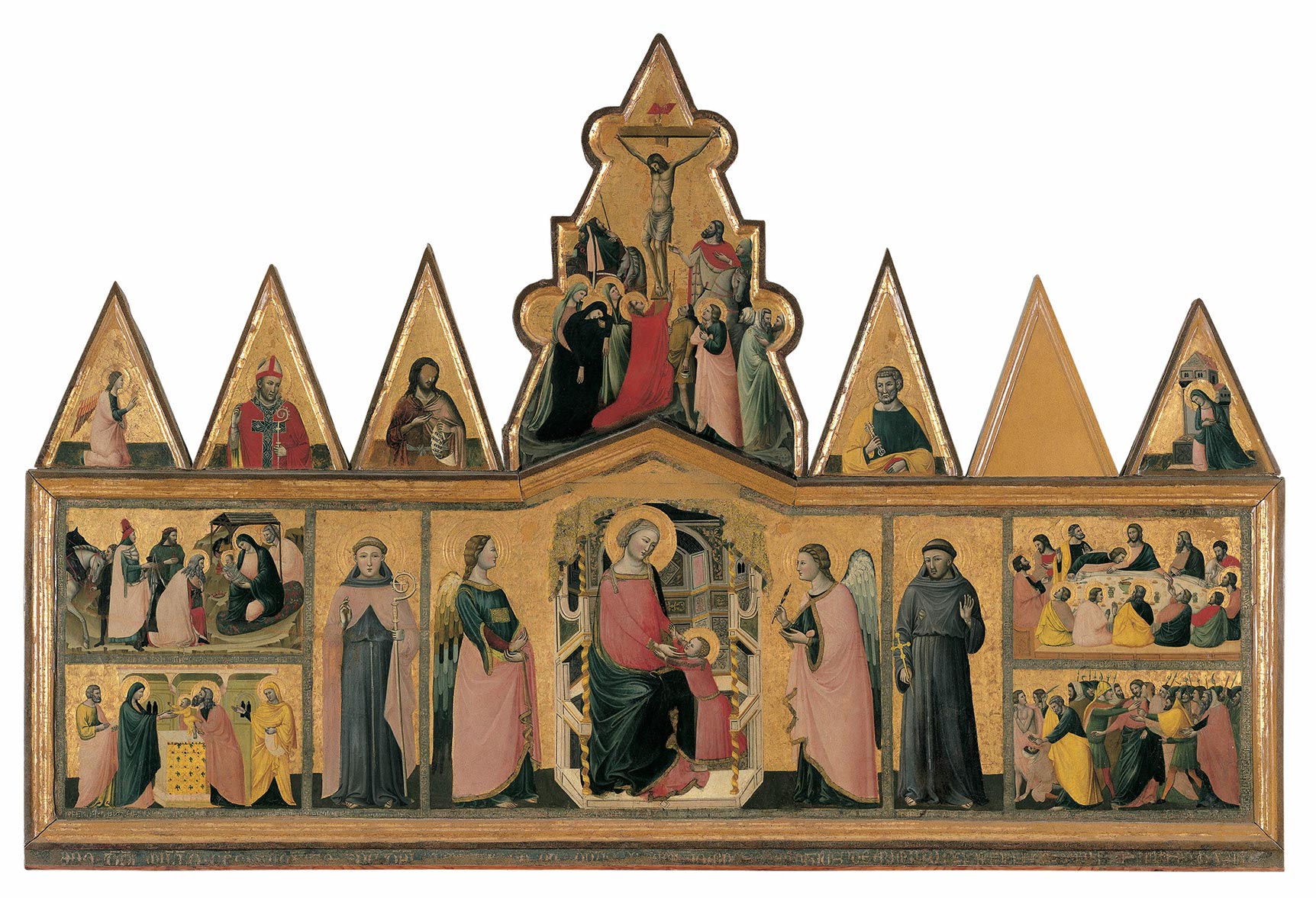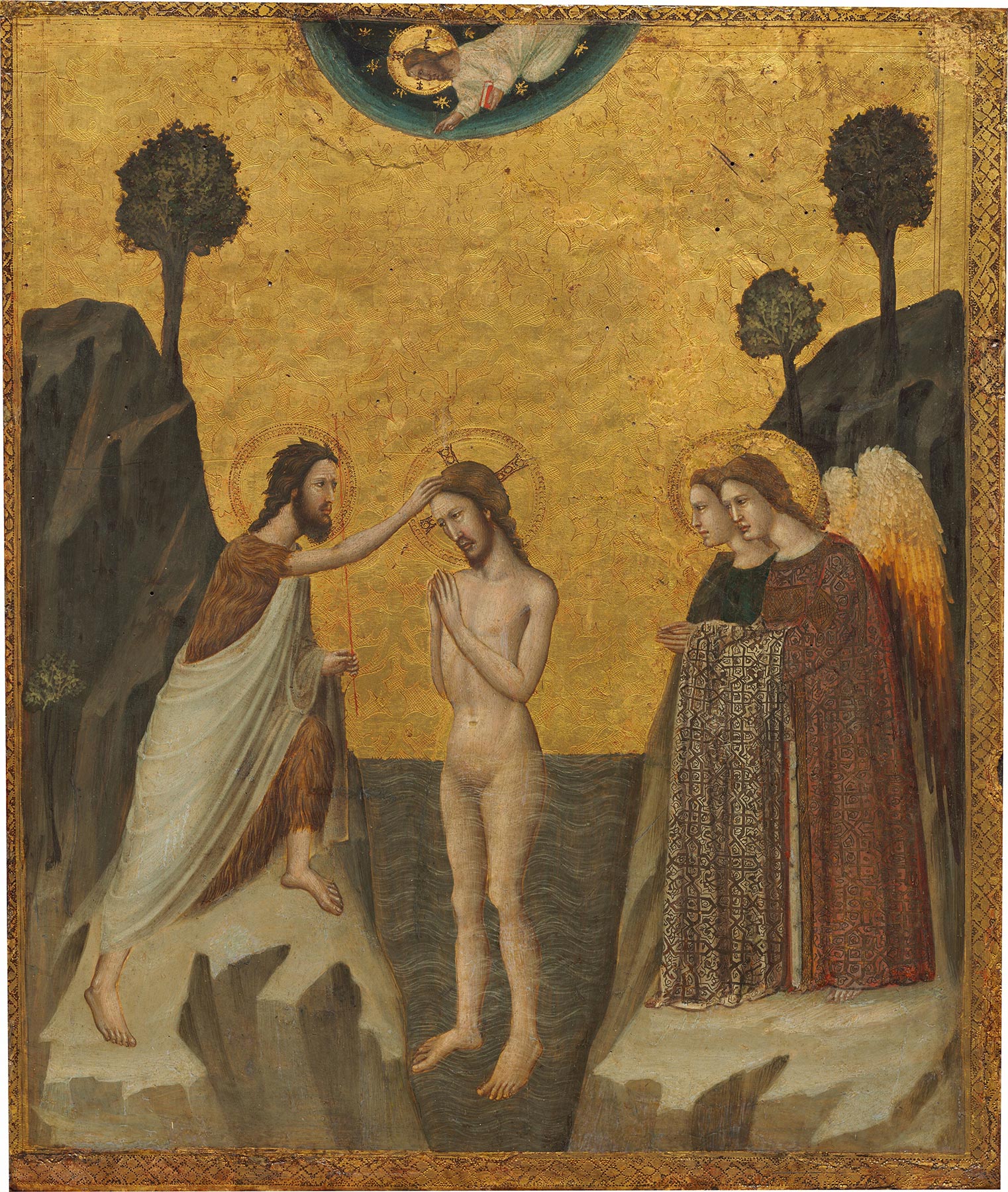Spink and Son Galleries, London, 1927;1 Richard M. Hurd Collection, New York, to 1945; sale, Kende Galleries at Gimbel Brothers, New York, October 29, 1945, lot 27; Hannah D. and Louis M. Rabinowitz (1887–1957), Sands Point, Long Island, N.Y.
The panel support, thinned to a depth of 1.3 centimeters or less, has been marouflaged into a larger panel support and heavily cradled. The wood grain of the original panel runs on a diagonal from upper left to lower right. The top of the panel has been cropped through the halo of the central angel and rebuilt. Two major splits or seams have opened at 21 and 32 centimeters from the left edge, measured along the bottom of the composition. Repaints along these splits and retouches of flaking losses in the darker draperies are completely masked by a thick, opaque varnish that obscures the entire surface. The sgraffito decoration of Christ’s red tunic is beautifully preserved, but it is not possible to judge how much of the chrysogony decorating His robe and the Virgin’s robe is original and how much is reinforcement. Shadows and folds in the cloth of honor have been reinforced and flattened, and gilding in the haloes has been locally repaired. More extensive repaints are in evidence across the bottom of the panel.
The panel, possibly the centerpiece of a larger complex and presently inserted into a modern neo-Gothic frame, has been significantly compromised by overall retouching, executed at an unknown date before it entered Yale’s collection.2 The Coronation of the Virgin is represented according to the Riminese formula developed by Giuliano da Rimini in a polyptych now in the Museo della Città di Rimini, which shows Christ and the Virgin seated on an invisible throne against a lavishly decorated cloth of honor held up by angels. Giuliano’s version, however, follows Venetian models in its depiction of a regal Christ holding a scepter in His left hand and crowning the Virgin with His right, whereas the present image is indebted, rather, to Giottesque Tuscan examples, with a more humble, bare-headed Christ placing the crown on His Mother’s head with both hands. The celestial dimension of the event is underscored by the profusion of decorated surfaces. Still discernible beneath layers of old varnish are the gold striations over the tunic of Christ and over the mantles of both Christ and the Virgin and the elaborate geometric designs incised over the Virgin’s dress. Although now largely repainted, the cloth of honor in the background must have shared a similar pattern of alternating geometric shapes in paint and sgraffito, comparable to that in Giuliano’s polyptych and in later Riminese examples.
When it first appeared on the art market in London in 1926, the Yale Coronation was described in an expert opinion as “an authentic and characteristic work by Giovanni Baronzio da Rimini,”3 and in 1932 it figured among the more than forty paintings assigned to the artist by Bernard Berenson.4 The attribution to Baronzio was accepted by Mario Salmi and reiterated, albeit with some reservations, by Cesare Brandi and Luigi Coletti.5 Following the reassessment of Baronzio’s activity and the separation of his personality from that of other Riminese painters, the Yale Coronation became one of only a handful of pieces still included in his autograph production. In his fundamental study on Riminese painting, Carlo Volpe listed the work alongside only two other images he gave to the artist in addition to the signed and dated 1345 polyptych in the Galleria Nazionale delle Marche, Urbino (fig. 1): a panel with scenes from the life of Christ in the Metropolitan Museum of Art, New York,6 and a polyptych in the church of San Francesco a Mercatello sul Metauro, in the Marche.7 According to Volpe, who compared the tooling of the haloes to that of the Mercatello polyptych, the Coronation reflected Baronzio’s technical as well as formal vocabulary, although full confirmation of its authorship, Volpe emphasized, could come only from a direct examination of the painting, which by that date was known to most scholars only from photographs. Volpe’s analysis was overlooked by Charles Seymour, Jr., who catalogued the Coronation as “School of Rimini” and tentatively associated it with the works then gathered under the label “Master of the Life of Saint John the Baptist”8—a group later recognized by Miklós Boskovits as the product of an early phase of Baronzio himself.9 Subsequent discussions of the Yale Coronation, even when confined to a passing reference, have implicitly concurred with Volpe’s assessment and unanimously inserted the painting among the artist’s mature efforts.

Notwithstanding its present condition, most aspects of the Yale Coronation conform to the formal and decorative idiom of Baronzio as reflected in the body of works currently ascribed to his hand. The heavy figural proportions and flattened profiles, characterized by rounded jaws and pointed chins, are closely related to those in the 1345 polyptych in Urbino, whereas the ornate surfaces and type of sgraffito decoration, as well as the earth-tone palette—as much as can be surmised of it from the present state of the panel—most nearly recall the ornamental vocabulary employed by the artist in the scenes from the life of Saint John the Baptist in the National Gallery of Art, Washington, D.C., which were recently dated by Boskovits to an earlier moment in his career, around 1335 (fig. 2).10 It is difficult to ascertain the extent to which certain features of the Yale Coronation, like the heavily outlined profiles and sharp definition of draperies, are the result of later reinforcements. Nevertheless, these elements seem consistent with the gradual evolution of Baronzio’s style in the last decade of his activity. The elaborate punchwork design in the figures’ haloes, as noted by Volpe, finds its nearest counterpart in the Mercatello polyptych, traditionally dated around the same moment as the Urbino altarpiece. The Mercatello polyptych is nevertheless distinguished from the Yale Coronation—as well as from the Urbino altarpiece—by a greater elongation of the figures and slackness of execution, viewed by Volpe as the result of the intervention of assistants. Within the limits imposed by its present condition, it seems most prudent for now to place the execution of the Yale Coronation at an intermediate phase in the artist’s career, following the execution of the scenes from the life of the Baptist and preceding the Urbino polyptych. —PP

Published References
Berenson, Bernard. Italian Pictures of the Renaissance: A List of the Principal Artists and Their Works with an Index of Places. Oxford: Clarendon, 1932., 44; Salmi, Mario. “La scuola di Rimini—II.” Rivista del R. Istituto d’Archeologia e storia dell’arte 4 (1932–33): 145–201., 194; Brandi, Cesare, ed. Mostra della pittura riminese del trecento: Catalogo. Exh. cat. Rimini: Garattoni, 1935., xxxii, 215, fig. 145; Italian Primitives: The Collection of Richard M. Hurd, Esq. Exh. cat. New York: Newhouse Galleries, 1937., no. 4; Kende Galleries at Gimbel Brothers, New York. Italian Primitives: Twenty-Seven Distinguished Panels by Italian Primitive Masters; The Collection of the Late Richard M. Hurd. Sale cat. October 29, 1945., 60–61, lot 27; Coletti, Luigi. I primitivi. Vol. 3, I padani. Novara: Istituto Geografico de Agostini, 1947., 69n20; “Recent Gifts and Purchases: February 22–December 31, 1959.” Yale University Art Gallery Bulletin 26, no. 1 (December 1960): 52–58., 53; Seymour, Charles, Jr. The Rabinowitz Collection of European Paintings. New Haven: Yale University Art Gallery, 1961., 7, 55; Volpe, Carlo. La pittura riminese del trecento. Milan: Fabbri, 1965., 43, 83, no. 78, fig. 209; Berenson, Bernard. Italian Pictures of the Renaissance, A List of the Principal Artists and Their Works with an Index of Places: Central Italian and North Italian Schools. 3 vols. London: Phaidon, 1968., 1:363, 2: fig. 194; Seymour, Charles, Jr. Early Italian Paintings in the Yale University Art Gallery. New Haven: Yale University Art Gallery, 1970., 107–8, no. 75; Vertova, Luisa. “The New Yale Catalogue.” Burlington Magazine 115 (March 1973): 159–61, 163., 160; Fahy, Everett. Review of Paintings from the Samuel H. Kress Collection: Italian Schools XII–XV Century, by Fern Rusk Shapley; Paintings from the Samuel H. Kress Collection: Italian Schools XV–XVI Century, by Fern Rusk Shapley; Early Italian Paintings in the Yale University Art Gallery, by Charles Seymour, Jr.; and Italian Primitives: The Case History of a Collection and Its Conservation, by Charles Seymour, Jr. Art Bulletin 56, no. 2 (June 1974): 283–85., 285; Andrea Bacchi, in Castelnuovo, Enrico, ed. La pittura in Italia: Il duecento e il trecento. 2 vols. Milan: Electa, 1986., 555; Boskovits, Miklós. Frühe italienische Malerei: Gemäldegalerie Berlin, Katalog der Gemälde. Berlin: Mann, 1988., 15; Freuler, Gaudenz. “Manifestatori delle cose miracolose”: Arte italiana del ’300 e ’400 da collezioni in Svizzera e nel Liechtenstein. Exh. cat. Lugano-Castagnola, Switzerland: Fondazione Thyssen-Bornemisza, 1991., 132; Benati, Daniele. “Baronzio, Giovanni.” In Enciclopedia dell’arte medievale. Rome: Istituto della Enciclopedia Italiana, 1992.; Daniele Benati, Benati, Daniele, ed. Il trecento riminese: Maestri e botteghe tra Romagna e Marche. Exh. cat. Milan: Electa, 1995., 30, 56n3, 264; Benati, Daniele. “Giovanni Baronzio nella pittura riminese del trecento.” In Giovanni Baronzio e la pittura a Rimini nel trecento, ed. Daniele Ferrara, 19–35. Exh. cat. Cinisello Balsamo, Milan: Silvana, 2008., 32, 35n47
Notes
-
According to Kende Galleries at Gimbel Brothers, New York. Italian Primitives: Twenty-Seven Distinguished Panels by Italian Primitive Masters; The Collection of the Late Richard M. Hurd. Sale cat. October 29, 1945., 60. ↩︎
-
A 1928 photograph by Mortimer Offner (Fototeca Zeri, Federico Zeri Foundation, Bologna, inv. no. 28089; and Frick Art Reference Library, New York), executed for its then owner, Raymond Hurd, shows the painting in substantially the same condition in which it is found today, but it is not possible to judge whether it had by then already been marouflaged and cradled. ↩︎
-
G. P. Konnody, London, cited in Kende Galleries at Gimbel Brothers, New York. Italian Primitives: Twenty-Seven Distinguished Panels by Italian Primitive Masters; The Collection of the Late Richard M. Hurd. Sale cat. October 29, 1945., 60, lot 27. ↩︎
-
Berenson, Bernard. Italian Pictures of the Renaissance: A List of the Principal Artists and Their Works with an Index of Places. Oxford: Clarendon, 1932., 44. ↩︎
-
Salmi, Mario. “La scuola di Rimini—II.” Rivista del R. Istituto d’Archeologia e storia dell’arte 4 (1932–33): 145–201., 194; Brandi, Cesare, ed. Mostra della pittura riminese del trecento: Catalogo. Exh. cat. Rimini: Garattoni, 1935., xxxii, 215, fig. 145; and Coletti, Luigi. I primitivi. Vol. 3, I padani. Novara: Istituto Geografico de Agostini, 1947., 69n20. ↩︎
-
Inv. no. 09.103, https://www.metmuseum.org/art/collection/search/435607. ↩︎
-
Volpe, Carlo. La pittura riminese del trecento. Milan: Fabbri, 1965., 41–43. ↩︎
-
Seymour, Charles, Jr. Early Italian Paintings in the Yale University Art Gallery. New Haven: Yale University Art Gallery, 1970., 107–8, no. 75. As pointed out by the reviews of Luisa Vertova (Vertova, Luisa. “The New Yale Catalogue.” Burlington Magazine 115 (March 1973): 159–61, 163., 160) and Everett Fahy (Fahy, Everett. Review of Paintings from the Samuel H. Kress Collection: Italian Schools XII–XV Century, by Fern Rusk Shapley; Paintings from the Samuel H. Kress Collection: Italian Schools XV–XVI Century, by Fern Rusk Shapley; Early Italian Paintings in the Yale University Art Gallery, by Charles Seymour, Jr.; and Italian Primitives: The Case History of a Collection and Its Conservation, by Charles Seymour, Jr. Art Bulletin 56, no. 2 (June 1974): 283–85., 285), Seymour’s statement that “the change of attribution from Baronzio to school of Rimini is in line with recent scholarship on Baronzio” is puzzling at best. Volpe’s study is omitted from discussion, nor is it included in the scant bibliography that accompanies the entry. ↩︎
-
Boskovits, Miklós. Frühe italienische Malerei: Gemäldegalerie Berlin, Katalog der Gemälde. Berlin: Mann, 1988., 15. ↩︎
-
Boskovits, Miklós. Italian Paintings of the Thirteenth and Fourteenth Centuries. Washington, D.C.: National Gallery of Art, 2016. NGA Online Editions, https://purl.org/nga/collection/catalogue/italian-paintings-of-the-thirteenth-and-fourteenth-centuries., 159–61, nos. 18–19. ↩︎